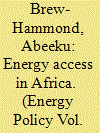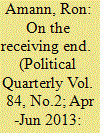| Srl | Item |
| 1 |
ID:
094913


|
|
|
|
|
| Publication |
2010.
|
| Summary/Abstract |
This paper presents a review of the current situation and projections for energy access in Africa. The paper also presents several sets of ambitious energy access targets as agreed by the regional groupings within the region. The paper argues that achieving between 50% and 100% access to modern energy services by 2030 in Africa will require more effective mobilization and use of both domestic and external funding, and the development and implementation of innovative policy frameworks. The paper suggests that greater emphasis will need to be placed on productive uses of energy and energy for income generation in order to break the vicious circle of low incomes leading to poor access to modern energy services, which in turn puts severe limitations on the ability to generate higher incomes. The paper further suggests that if anything near the ambitious targets set by African organisations are to be achieved then it will be advisable to tap into the full menu of energy resource and technology options, and there will be the need for significant increases in the numbers of various actors involved together with more effective institutions in the energy sector.
|
|
|
|
|
|
|
|
|
|
|
|
|
|
|
|
| 2 |
ID:
092840


|
|
|
|
|
| Publication |
2009.
|
| Summary/Abstract |
In December 2008, the European Council and the European Parliament agreed on a final compromise for a new European renewable energy directive. One of the most debated issues prior to this compromise was the design of "target flexibility mechanisms", which should allow member states with low or expensive renewable energy potential to partly fulfil their national renewable energy target in other countries. This article traces back the political discussion that has led to the evolution of the different flexibility options. It then evaluates the most prominent flexibility mechanisms against a set of qualitative criteria. It concludes that free or restricted certificate trade based on guarantees of origin (GOs) - as proposed earlier by the European Commission - is not a viable option due to some "knockout" criteria, despite other potential advantages. The mechanisms that have replaced GO trade in the final compromise - joint projects, joint support schemes and statistical transfer between member states - provide less flexibility, but score better against a number of other important criteria. The crucial question for the coming years is how their utilisation can be facilitated. One first step might be that proactive member states define open design issues for implementing the mechanisms.
|
|
|
|
|
|
|
|
|
|
|
|
|
|
|
|
| 3 |
ID:
098951


|
|
|
| 4 |
ID:
084274


|
|
|
| 5 |
ID:
122480


|
|
|
|
|
| Publication |
2013.
|
| Summary/Abstract |
Based on direct observation over a five-year period, the article paints an intimate picture of how the police in Britain are governed. It analyses the complexity of the economic and political environment in which the police have to work: the insecure funding platform; the stream of initiatives, targets and official guidelines; the delicacy of handling community sensitivities; the inherent opaqueness of the national 'tripartite' system of governance; and the constant challenge of making balanced judgements under conflicting pressures. The central theme that runs through the article (which follows on logically from two previous articles published in Political Quarterly) is that of a 'managerialist' political class, with a distinctive ideology and mode of control, trying to get a policy grip on the real world of service delivery: in this instance, policing. Unlike the previous two articles, which had a top-down focus, the emphasis here is primarily on how the thicket looks to those who have to navigate their way through it.
|
|
|
|
|
|
|
|
|
|
|
|
|
|
|
|
| 6 |
ID:
084271


|
|
|
| 7 |
ID:
084269


|
|
|
| 8 |
ID:
173885


|
|
|
|
|
| Summary/Abstract |
Existing research on terrorism as a strategy has largely neglected the apparent differences in what groups target. Whereas some organizations primarily target undefended civilians, others attack mainly official and hard targets. I develop an explanation of terrorist groups’ relative target preferences based on how a group’s ties to its constituency and specific government repressive strategies either constrain or incentivize terrorist attacks against soft civilian vs. hard/official targets. Specific sources of support and the degree of out-group antagonism in their constituency shape terrorist groups’ primary targeting strategy. While groups with transnational support are generally more likely to target primarily undefended civilians, not all groups with local support are restrained. Groups with low out-group antagonism and local civilian support incur high political costs for targeting civilians and focus primarily on official targets. Instead, groups with domestic support but high out-group antagonism have mixed incentives. When facing indiscriminate government repression these groups become more likely to target primarily undefended civilians, because they can justify such a response to their audience, direct attacks against out-group civilians, and radicalize local constituents. Indiscriminate repression, however, does not change the targeting strategy of groups who face high political costs for attacking civilians. I examine the observable implications of the theory in a comparative analysis of terrorist organizations (1995–2007) as well as an over-time analysis of repression and targeting in the Israeli–Palestinian conflict (1987–2004), and find strong support for the theoretical argument.
|
|
|
|
|
|
|
|
|
|
|
|
|
|
|
|
| 9 |
ID:
171007


|
|
|
|
|
| Summary/Abstract |
Suicide terrorist attacks are theorized to provide militants with various strategic advantages. Among these is the ability to successfully strike against well-defended or ‘hard’ targets. Scholars argue that because suicide attacks produce higher levels of damage and do not require an escape route for the perpetrator, they are particularly effective against hard targets. Consequently, militants should be expected to use such attacks more frequently, and successfully, against hard targets. This study empirically tests this contention using incident-level data on between 22,000 and 170,000 terrorist attacks in between 154 and 175 countries for the period 1970–2016. It makes two key findings. First, suicide attacks are both more frequently deployed against hard targets, and are more often successfully executed against hard targets. Second, this finding is not a product of foreign military interventions, as previous literature might suggest. Suicide attacks are found to be more likely to be launched against, with success, both domestic and foreign military targets. This underscores the importance of qualities of the target itself when explaining the strategic decision to use suicide attacks by militant groups.
|
|
|
|
|
|
|
|
|
|
|
|
|
|
|
|